Battle of the 50mm Primes
By EricMesa
- 6 minutes read - 1238 words[caption id="" align=“aligncenter” width=“500” caption=“Which 50mm lens is the best? The Canon EF 50mm f/1.8 II or the Canon EF 50mm f/2.5 Compact Macro?”] 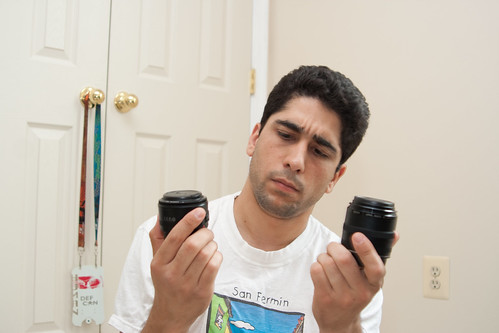 [/caption]
[/caption]
I have as of a few months now, I have two 50mm prime lenses - the Canon EF 50mm f/2.5 Compact Macro and the Canon EF 50mm f/1.8 II.
I wanted to compare them to see if one is clearly better for another. After all, if I’m going to use a prime lens, why not use the best one? Before we get to the photo comparisons, let’s take a look at the other factors.
Weight
The f/1.8 not only looks to be about 60% of the size of the f/2.5 Macro, but it actually weights half as much. B&H lists the f/1.8 at .29 lbs and the f/2.5 Macro at .61 lbs. Neither one is exceptionally heavy, especially if you’ve ever held the EF 70-200mm f/2.8! But if you require the lightest lens the f/1.8 is the way to go and over a long day may feel better.
winner: f/1.8
Materials/Price
The f/1.8 is the cheapest EF lens Canon makes. Although it has long been listed at $90, recent economic events have caused Canon to raise the price and it is now listed on B&H for $114. Therefore it should be no surprise that it looks and feels cheap. It’s wholly made of plastic and a lot of people complain that it feels cheap and that bothers them. Frankly, as long as it doesn’t break easily I don’t care as long as the photos come out good. (And they do!) The f/2.5 is currently listed on B&H for $274. It is definitely a more solid construction. While parts of the body are plastic, the mount is metal and feels very snug when you mount it onto your EOS body. Also it has a distance window for manual focus (as you can see below on the right). Based on materials and price, basically you get what you pay for.
materials winner: f/2.5
price winner: f/1.8
[caption id="" align=“aligncenter” width=“500” caption=“The extension length of the Canon EF 50mm f/1.8 II vs Canon EF 50mm f/2.5 Compact Macro”] 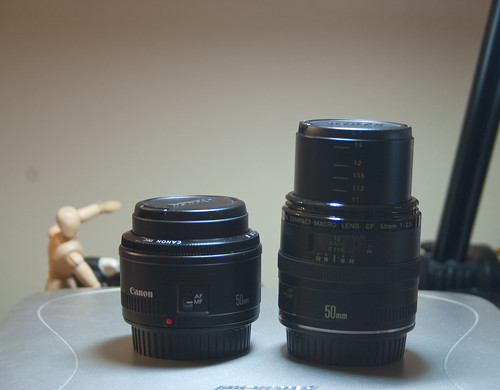 [/caption]
[/caption]
Maximum Focus Extension Length
As you can see above, the f/2.5, on the right, extends a lot further out when you’re focusing close than the f/1.8 does. Is this a big deal? It is to some people. It means if you’re close to your subject you’ve gotta be a little careful. It also tends to suck in more dust than a lens that doesn’t change length when focusing. It’s really not that big a deal, but it does bother some.
winner: f/1.8
Focus ring
Whether you do it regularly or not, one day you will need to manually focus your camera. The focus ring is what you turn in order to manually focus. The f/2.5 has a decent-sized focus ring. The f/1.8 has a vestigial ring that seems about to evolve right off the lens. It’s more or less like the kit lens that came with the EOS 350D. The f/2.5 wins without major contest.
winner: f/2.5
Closest Focal Distance
The f/1.8 can focus as close as 0.45 meters. The f/2.5 macro can focus as close as 0.22 meters. Makes sense - the f/2.5 is a MACRO lens. So the f/2.5 easily wins. Unless you don’t need the macro functionality.
[caption id="" align=“aligncenter” width=“240” caption=“A macro shot taken with the Canon EF 50mm f/2.5 Compact Macro”]  [/caption]
[/caption]
winner: f/2.5, but trivial if you don’t ever intend on doing macro photography
Sound While Focusing
This is another one of those features that, like the extension of the lens when it focuses, bothers some, but not others. It’s one of the selling points of why people buy USM lenses. They are both orders of magnitude much louder than my USM lenses when they are auto focusing. The f/2.5 is a bit louder than the f/1.8. Does it matter? Maybe, if you’re trying to photograph a baby without waking it up or an animal without startling it. Or if you’re in a museum or church. At the ball park no one will care.
winner: f/1.8
Low Light Performance
In the same way that the f/2.5 automatically wins on the closest focal distance, the f/1.8 automatically wins on low light performance. Opening the aperture all the way to f/1.8 allows a lot more light into the lens and lets the photographer capture photos in lower light than they might otherwise be able to. Using the f/1.8 you can take photos at night and not have to use your flash. (If the conditions are right)
[caption id="" align=“aligncenter” width=“240” caption=“A low light photo taken with the Canon EF 50mm f/1.8 II”]  [/caption]
[/caption]
winner f/1.8
Now onto the photo comparisons. I put my camera on a tripod and photographed the same scene at different f-stops to do a comparison to see where the lenses differ. First off, opened up to their maximum apertures.
Maximum Aperture (f/1.8 and f/2.5)
[caption id="" align=“aligncenter” width=“500” caption=“Canon EF 50mm f/1.8 II Wide Open”]  [/caption]
[/caption]
[caption id="" align=“aligncenter” width=“500” caption=“Canon EF 50mm f/2.5 Compact Macro Open Wide”]  [/caption]
[/caption]
First of all, the f/1.8 is (at 100% zoom) actually sharper wide open than the f/2.5. On the other hand, the photo seems brighter in the f/2.5 photo. So, wide open if you want sharper photos, the f/1.8 wins. But colour-wise the f/2.5 wins.
winner: tie
At f/2.8
[caption id="" align=“aligncenter” width=“500” caption=“Canon EF 50mm f/1.8 II @ f/2.8”]  [/caption]
[/caption]
[caption id="" align=“aligncenter” width=“500” caption=“Canon EF 50mm f/2.5 Compact Macro @ f/2.8”] 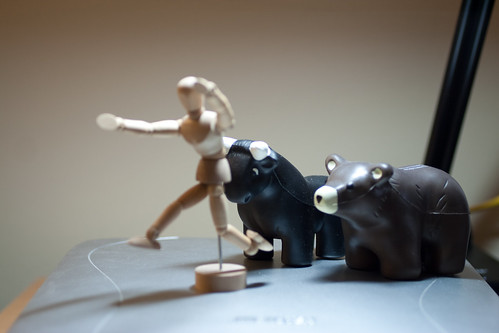 [/caption]
[/caption]
Once again f/1.8 wins for sharpness. This time the colour saturation is about the same.
winner: f/1.8
At f/8
[caption id="" align=“aligncenter” width=“500” caption=“Canon EF 50mm f/1.8 II @ f/8”] 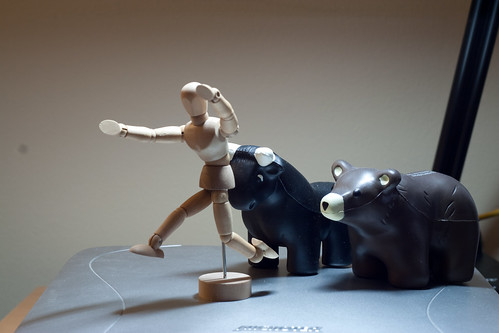 [/caption]
[/caption]
[caption id="" align=“aligncenter” width=“500” caption=“Canon EF 50mm f/2.5 Compact Macro @ f/8”] 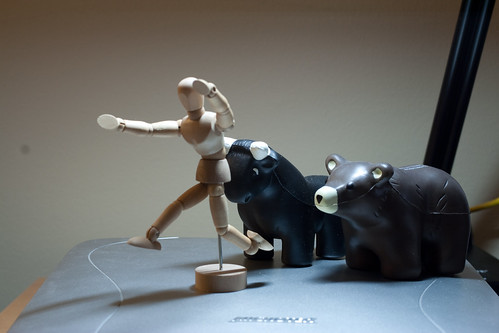 [/caption]
[/caption]
I chose f/8 because it’s often recommended as a good f-stop for sharpness. Now both lenses have the same sharpness. f/1.8 has better colour saturation
winner: tie
At f/11
[caption id="" align=“aligncenter” width=“500” caption=“Canon EF 50mm f/1.8 II @ f/11”] 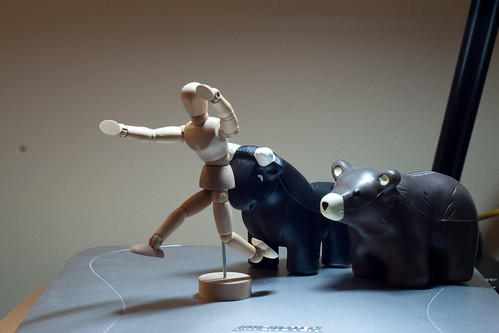 [/caption]
[/caption]
[caption id="" align=“aligncenter” width=“500” caption=“Canon EF 50mm f/2.5 Compact Macro @ f/11”]  [/caption]
[/caption]
f/11 is supposed to be the greatest you can stop your lens before diffraction starts to wreak havoc. The f/2.5 is finally sharper. The f/1.8 still has better colour saturation
winner: f/2.5
Conclusions
First of all, this isn’t completely scientific. I tried my absolute best to keep the camera in exactly the same place and to focus on the exact same place each time. But I’m extremely surprised that the f/1.8 worked so darn well for the f-stops I tested. I mean, in the real world I have been impressed with the f/1.8 in a way that I hadn’t been since I got the f/2.5, but I thought the macro would be better quality.
Well, based on features, the winner was the f/1.8 by 5 to 3.
Based on photos, it was a tie 3 to 3.
So basically you need to look at what types of photos you will be taken and buy your lens based on that. They both appear to be very good, but the f/1.8 eeked ahead and is recommended for your first prime lens, especially if money is a concern. But if you want to explore macro, you can’t beat the f/2.5. Hope that helps, I know I was very surprised with the results.